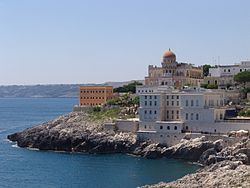Demonym(s) Cesarini Local time Tuesday 11:16 PM Postal code 73020 | Elevation 56 m (184 ft) Area 26 km² Dialling code 0836 | |
 | ||
Frazioni Cerfignano, Porto Miggiano, Vitigliano Weather 12°C, Wind NW at 3 km/h, 94% Humidity | ||
Santa cesarea terme drone underwater
Santa Cesarea Terme is a town and comune of 3,100 inhabitants in province of Lecce, in Apulia, southern Italy.
Contents
- Santa cesarea terme drone underwater
- Map of 73020 Santa Cesarea Terme Province of Lecce Italy
- Si scia sulla neve a santa cesarea terme
- References
Map of 73020 Santa Cesarea Terme Province of Lecce, Italy
Situated on the coast at the entrance of the Strait of Otranto, on a part of the coast which comes down to the sea, the town of Santa Cesarea is one of the largest centers for thermal baths in the Salento. The use of the waters, coming from four caves, dates back to 1500. The economy of the whole town is based on the baths, which offer various facilities.
There are two legends, one Christian, the other pagan, which explain the origins of the town. The pagan story says that the coastal area, which for hundreds of years was called Leuterni was named after the giants called Leuterni. Greek mythology states that the Giants Leuterni conducted a war against the Gods. They were thought to be unbeatable because they were made hard in the fire and sulfur of the area. Hercules defeated some of them, however, at the Phlegraean Fields near Naples. Other giants escaped and hid in the caves of the Salento coast, the present site of Santa Cesarea. The decaying of their bodies seeped into the ground causing the water to become sulfurous. Around the 15th century the pagan myth was replaced by another Christian story. At that time the Lido Leuterno was called Santa Cisaria, and then Santa Caesarea. The popular tradition explains that a young girl named Cisaria ran away from home and hid in the Sulfurous Cave, escaping from her father who desired her. He succeeded to find her in the cave, but sudden bursts of sulfur saved the girl from him. In both legends the sulfurous waters are caused by the decay of the bodies of evil ones. but in the Christian legend the waters become purified by the young, Christian girl, and now the waters have healing properties.
A relatively new town, its development on a rocky coastline, riddled with underground caverns and fissured rock strata, was encouraged by the presence of hot natural springs. These hot mineral springs, with thermal waters rich in iodine, sulphurs and sodium chloride, rising up through the porous bedrock of the area from deep underground, have formed a network of aquifers that puncture the underlying rock strata before draining through cave systems into the cold salty waters of the Adriatic Sea.
The city includes many sulphurous grottos such as the four cisterns of Feidida, Solfurea, Gattula and Solfatura whose waters at different temperature ranges have encouraged the towns development into a spa.
Known throughout early history, it was only in the 1700s that upper class citizens and the local aristocracy started to build residences here for holidaying whilst indulging in the health giving waters of the mineral springs.
Over the years the Villas, Palazzos and summer residences extended the town, and avenues connected them whilst other places in the town developed with hotels and accommodations for visitors from further afield.
Some of the more indulgent residences were designed and constructed in various styles such as Palazzo Sticchi, hanging from the cliff face and built in the style of Moorish architecture. Villa Raffaella has been converted to apartments.
Today the town is a tourist destination, with the seafront promenades thronged with cafes and small shops, pizzerias and restaurants, where it is possible to sip coffee or dine al-fresco on the outside terraces with views to the sea just 100 metres (330 ft) away.
The thermal baths are open from May to November, and the waters are regulated at a temperature of less than 40 °C (104 °F) as indicated for therapeutic usage. The various hot mud and mineral treatments combat arthritic and rheumatoid problems, as well as respiratory, dermatological, trauma and stress ailments. They are also recommended for general well being and beauty treatments.
Behind the town, the scenery comprises low rolling hills, interspersed with long rocky outcrops covered with low Mediterranean shrubland, comprising grassland and scrub, tangy with the smell of wild herbs. In the spring and early summer, wild flowers bloom.
The landscape disintegrates into a rocky litoranea tumbling into the sea and stretching away to the north and south in a fractured coastline, with deep blue water foaming at the lands edge, whilst small sandy coves such as Porto Miggiano break up the rocky coastal ridges that are woven with half submerged caverns and grottoes.
